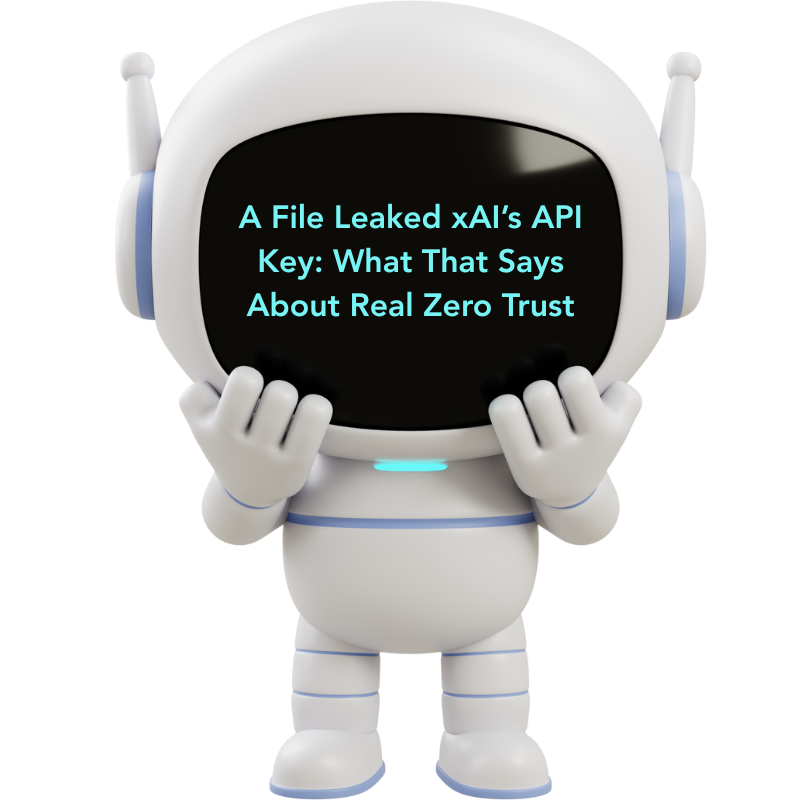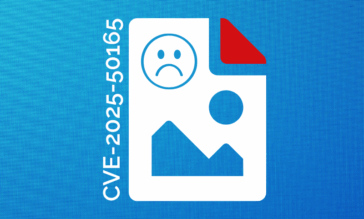A File Leaked xAI’s API Key: What That Says About Real Zero Trust

For all the noise about rogue AI behavior and model alignment risks, the most revealing security incident of the month came from something far less exotic: a single file, accidentally uploaded to GitHub.
That file, an unremarkable Python script, contained an API key granting access to 52 proprietary language models developed by xAI, Elon Musk’s AI venture. The developer behind the mistake, a DOGE staffer named Marko Elez, had embedded the key directly in the code. No breach, no hack, no malware. Just a forgotten config file sitting in a public repo, exposing a wake of infrastructure with a single line.
It’s the kind of incident that perfectly illustrates how fragile the modern AI stack is. While the world worries about sentient models or prompt injection attacks, the real risks often come from overlooked content flowing silently between devs, tools, and platforms.
And the frustrating part? This was entirely preventable. With the right file-level controls, this key never would’ve made it out of staging, let alone into the wild.
The Real Threat Isn’t the Model—It’s the Middleware
The real lesson here isn’t about the capabilities of large language models; it’s about everything wrapped around them. Behind every chatbot or API call is a patchwork of scripts, repos, dependencies, and shared files moving across teams and tools. And some of the most serious risks take shape in those quiet corners of the stack, far from the model itself. To understand what went wrong with xAI, we must stop staring at the model and start looking at the middleware.
The Dev Stack is the Attack Surface
Speed is everything in AI development, but that speed often comes at the expense of security. Teams move fast, prototype fast, and deploy even faster, constantly sharing code across GitHub, Jupyter notebooks, Slack threads, and browser-based IDEs. In this rapid-fire environment, files are the default currency of collaboration, and that’s exactly where the cracks begin to show.
A single Python script might include hardcoded .env values. A zipped dataset could contain sensitive customer information. A seemingly harmless notebook may quietly carry an unrestricted API key. None of this is malicious; it’s just routine. However, that routine becomes dangerous when internal files are assumed safe and allowed to flow freely across platforms and people without inspection.
And while most organizations have hardened their external defenses, internal trust still runs deep. Files passed between teammates often skip a security review entirely. They’re pushed, shared, uploaded, or emailed with the assumption that “internal” equals “secure.” But as the xAI leak proved, that assumption breaks down fast when even one overlooked file can expose the whole system.
When Zero Trust Stops at the File Boundary
According to Devin Ertel, CISO at Menlo Security, “Zero trust is not just a policy. It’s a design pattern.” Too many organizations claim to follow Zero Trust, verifying identity, restricting access, and segmenting networks while completely overlooking the content flowing within those boundaries. The trust stops at the person or the platform, not the file.
And that’s where it falls apart. Internal file uploads, shared dev artifacts, and auto-synced config files are often assumed clean by default. If a script comes from an internal GitHub repo or a teammate’s Slack message, it sails through. But this “trust-by-association” logic directly violates the principles of Zero Trust, where every asset, no matter its source, is treated as potentially unsafe until proven otherwise.
Votiro’s Zero Trust Data Detection and Response (DDR) capabilities help organizations address that gap. Votiro enforces Zero Trust at the content layer, automatically sanitizing and-or masking every file before it enters your environment. No assumptions. No skipped steps. Just real, enforceable protection in the one place most security stacks still ignore.
What If This File Had Been Masked?
The damage from the xAI leak didn’t come from some zero-day exploit or advanced adversary. It came from a single, info-ladden file slipping through the cracks. And while the consequences were high, the solution could’ve been simple. This wasn’t a failure of detection. It was a failure to prevent. So let’s rewind the scenario and consider what might’ve happened if that file had been intercepted before it ever made it to GitHub.
Making Data Exposures a Non-Event
If the leaked xAI file had passed through Votiro first, this story could’ve ended before it began.
Votiro DDR identifies and masks sensitive data like personally identifiable information (PII), account numbers, and other regulated content in real time. Whether it’s financial data, healthcare info, customer details, or even Material Non-public Information, DDR ensures that sensitive fields are handled before they become exposure risks—all thanks to fine-grain security controls. The result? A file that’s safe to share, without compromising compliance or privacy standards.
Also layered within Votiro DDR is advanced Content Disarm and Reconstruction (CDR) technology, which doesn’t wait for a file to trigger a scan or raise a red flag. It proactively rebuilds each file from the ground up, removing any embedded macros, hidden scripts, or improperly stored secrets, even in files moving between trusted internal systems. No exceptions, no assumptions.
Had that Python script contained customer data or regulated content, Votiro’s DDR would have caught it before it ever reached a shared folder or internal repo. While it may not catch every misplaced API key, it’s designed to ensure that sensitive data doesn’t silently hitch a ride into development environments, especially ones powering AI systems. That’s the real value: enforcing guardrails where none typically exist. By automatically sanitizing inbound files and flagging risky content before it enters your workflows, Votiro helps teams prevent the quiet mistakes that lead to loud consequences.
Stop Thinking Files Are Safe Because the People Are
Trust in people doesn’t translate to trust in content, especially when the stakes involve production environments, sensitive data, or API access to critical infrastructure.
Just ask xAI. One trusted developer. One overlooked file. Fifty-two models exposed.
Votiro is built to break that assumption. It applies Zero Trust principles to every file regardless of where it came from, who sent it, or how familiar it looks. There’s no special treatment for internal uploads. No blind spots for shared scripts. Just one rule: every file is actioned on.
And it doesn’t come with extra overhead. There’s no training, no workflow changes, no productivity trade-offs. Votiro works silently behind the scenes, fast, automatic, and invisible. It perfectly fits high-velocity environments where files are constantly in motion and security can’t afford to blink.
Bridging the Unseen (Weak) Link in AI Security
As the xAI leak proved, the real threats aren’t always headline-grabbing. Sometimes, they’re buried in a single file passed internally, committed hastily, or shared without scrutiny.
And these kinds of mistakes aren’t rare. They’re routine. And they’re a byproduct of speed-first development environments that skip over basic hygiene in the name of progress. It’s not that organizations don’t care about security; the guardrails haven’t kept up with how we build, collaborate, and ship AI systems. Yet, Zero Trust remains Zero Trust—no matter the innovation.
Votiro doesn’t just secure files, it closes the gap that most teams don’t realize is wide open. Try Votiro and see how you can secure your LLM at the file level.
News you can use
Stay up-to-date on the latest industry news and get all the insights you need to navigate the cybersecurity world like a pro. It's as easy as using that form to the right. No catch. Just click, fill, subscribe, and sit back as the information comes to you.
Sign-up Here!
Subscribe to our newsletter for real-time insights about the cybersecurity industry.



